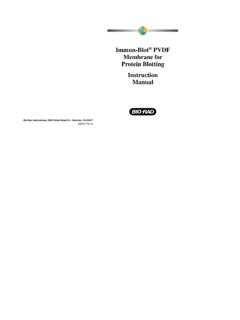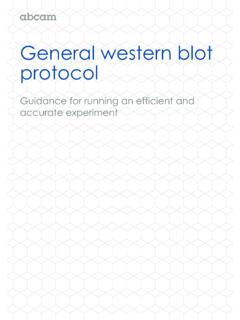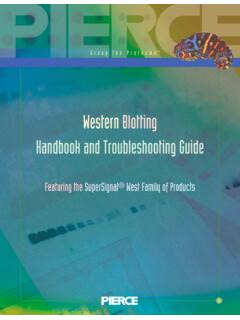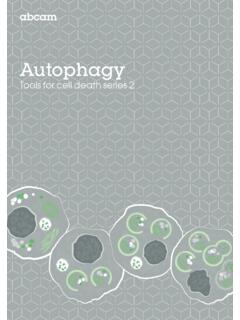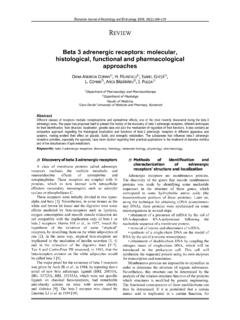Transcription of Co-immunoprecipitation (co-IP) Troubleshooting Guide
1 TECH TIP 1 Thermo Fisher Scientific Industrielaan 27 +32 53 83 44 04 Industriezone III 9320 Erembodegem, Belgium +32 53 83 76 38 fax Introduction I. IP Workflow II. General Considerations for immunoprecipitation (IP)/Co-IP III. Troubleshooting immunoprecipitation : From Start to Finish immunoprecipitation methods (IP, co-IP, ChIP and others) typically require a great deal of optimization and Troubleshooting . While in most cases the critical factor is the antibody, several other factors can significantly influence the outcome of the IP. These guidelines will help you to obtain the best possible results from your IP.
2 The first section provides general recommendations, which should be considered when you are setting up your IP. The Troubleshooting section describes alternatives in greater detail. Co-immunoprecipitation (co-IP) Troubleshooting Guide Thermo Fisher Scientific Industrielaan 27 +32 53 83 44 04 Industriezone III 9320 Erembodegem, Belgium +32 53 83 76 38 fax 2 I. IP Workflow When starting an IP, the following workflow will help to minimize the time for optimization: Cell Lysis: Cell lysis from tissue or cell culture is straightforward for Western blotting applications in which harsh lysis conditions ( , an SDS-sample loading buffer) will not interfere with the results, as the sample will be denatured during processing.
3 For an IP/co-IP, the lysis should be relatively mild so as not to interfere with the antibody-antigen binding, but harsh enough to efficiently extract proteins from the cells. It can be especially challenging to find the perfect compromise for membrane proteins. The non-denaturing Thermo Scientific Pierce Cell Lysis Reagents, which are all tested for IP, are a good choice for obtaining high protein yields while retaining the proteins activity. Pre-Clearing: No resin is totally inert, and the more complex the sample, the more background binding can occur. (Lists from tissue typically give significantly more background problems than lysates from cell culture.)
4 The pre-clearing step will reduce the background that is due to adhesion of sample components to the resin. This step should not be omitted without very good reason. Binding: The idea of the binding step is to generate the ternary complex of resin, antibody and antigen (protein). The buffers used in this step (as well as in the washing step) are crucial elements for success. The order of addition of these three components can also be critical. Antibodies can be pre-bound to resins (covalently or non-covalently) and the lysate can then be added to the immobilized antibody. Alternatively, the (non-immobilized) antibody can be incubated with the lysate to form the antibody:antigen complex in solution.
5 Next, the Immobilized Protein A or G Resin is added to purify the antibody:antigen complex from the mixture. You may want to compare both protocols to see which provides the best results in your particular biological system. Washing Buffer: Ideally, washing will break all nonspecific interactions while preserving the specific interaction between antibody and antigen (and antigen and binding partners for co-IP). Washing with additional Lysis Buffer is common, as it typically contains mild denaturants that can help break nonspecific interactions. If background is a problem, increasing the stringency of the wash buffer may help obtain a more purified antigen and antigen-binding partners from the sample.
6 Elution: Usually accomplished with very harsh conditions such as boiling of the beads in a Reducing SDS-Sample Loading Buffer. When using immobilized antibodies, milder conditions (pH-shift) are applied to avoid disruption of the antibody. In this case, only antigen (antigen and binding partners for co-IP) are eluted free of antibody contamination. Detection: Typically performed by Western blotting. In co-IP experiments often very small amounts of protein are available for detection, so high-sensitivity Western blotting substrates are required. Consult the thermo Scientific Pierce Western Blotting Handbook and Troubleshooting Guide for detailed suggestions.
7 To allow optimization, always check the following control samples together with the desired eluate: Lysate in IP-Buffer positive control confirms sample contains protein of interest. If not detectable, your sample may not have the protein of interest. However, consider dimerization/multimerization of protein if bands are not visible at the size of the monomer. IP Flow-Through confirms whether antigen or binding partners bound to immobilized antibody beads. 1st Wash Step provides information on whether Wash Buffer is excessively stringent. Post-Elution Bead-Boil boiling beads following elution in Reducing SDS-Sample Loading Buffer to confirm efficiency of the elution.
8 Thermo Fisher Scientific Industrielaan 27 +32 53 83 44 04 Industriezone III 9320 Erembodegem, Belgium +32 53 83 76 38 fax 3 II. General Considerations for IP/co-IP This section provides protocol details on some key steps of the IP process. Pre-clearing: Incubate samples with an inert resin (in column or batch format) such as underivatized agarose or Protein A-agarose for 30 minutes at 4 C. IP Buffers: The stringency of the buffer used during the binding step can be critical, enhancing binding without interfering due to excess stringency. High stringency: RIPA buffer (not recommended for co-IP as it is partly denaturing due to the anionic detergent SDS).
9 Medium stringency: NP-40 or Triton X-100 based buffers in TBS pH (up to 1% detergent). CHAPS-based buffers for membrane proteins (up to 1-2%). Low stringency: PBSCM (PBS buffer (100 mM sodium phosphate, 150 mM NaCl, pH ) with 1 mM CaCl2 + 1 mM MgCl2) or Modified Dulbecco s PBS (8 mM sodium phosphate, 2 mM potassium phosphate, 140 mM NaCl and 10 mM KCl, pH ). Often used as IP-binding buffers. In addition to the stringency of the binding buffer, you may need to include additives, if required for the protein: protein interaction, especially for co-IP. For example, if ATP is required for two proteins two interact and bind, this should be included in the buffer used for the binding step.
10 In vivo Crosslinking: Several articles have been published, that demonstrate how a mild in vivo crosslinking treatment can provide superior results in ChIP ,2 Alternatively, photo-amino acids, which are zero-length linkers, can provide an excellent way to capture the binding before starting a A label-transfer method is a valuable alternative or can act as a confirmation method for co-IP, when it is possible to use a (recombinant) bait protein, instead of an antibody, to bind the prey Choice of Protein A or Protein G Resin: Protein G is often considered a more universal IgG Binding Protein than is Protein A, but different species, and subtypes of species, do vary in their binding to these proteins.

